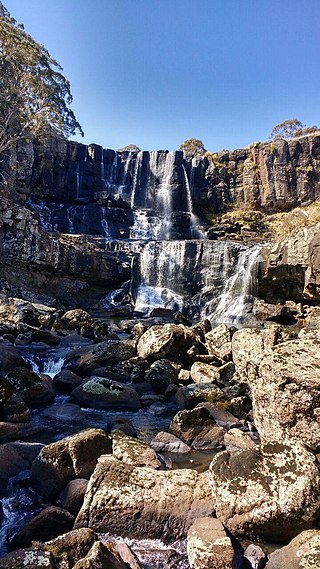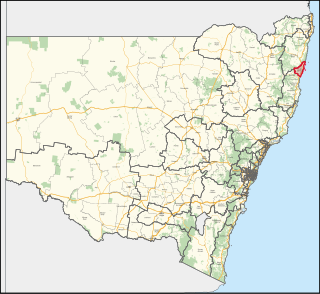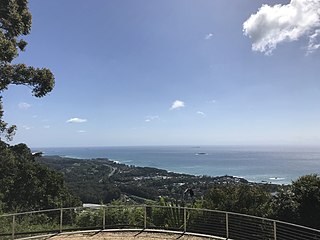
Ebor is a village on Waterfall Way on the Northern Tablelands in New South Wales, Australia. It is situated about 80 km (50 mi) east of Armidale and about a third of the way between Armidale and the coast. Dorrigo to the east is 46 kilometres (29 mi) away with the Coffs Coast 55 kilometres (34 mi) away along Waterfall Way. In the 2021 census, Ebor's zone had a population of 149.

Coffs Harbour, locally nicknamed Coffs, is a coastal city on the Mid North Coast of New South Wales, Australia, 540 km (340 mi) north of Sydney, and 390 km (240 mi) south of Brisbane. It is one of the largest urban centres on the North Coast, with a population of 78,759 as per 2021 census. The Gumbaynggirr are the original people of the Coffs Harbour region.

The National Library of Australia (NLA), formerly the Commonwealth National Library and Commonwealth Parliament Library, is the largest reference library in Australia, responsible under the terms of the National Library Act 1960 for "maintaining and developing a national collection of library material, including a comprehensive collection of library material relating to Australia and the Australian people", thus functioning as a national library. It is located in Parkes, Canberra, ACT.

Coffs Harbour is an electoral district of the Legislative Assembly in the Australian state of New South Wales. Since 2019 it has been represented by Gurmesh Singh of the National Party.

Eungai is a town on the mid-North Coast of New South Wales, Australia. It is made up of two localities, Eungai Creek and Eungai Rail, although both have the same postcode. The Eungai district is midway between Sydney (500 km) and Brisbane, midway between Port Macquarie (90 km) and Coffs Harbour, and midway between Kempsey (20 km) and Macksville. It is in the Nambucca Valley. It has a population of 605 in the 2021 census.
Humphrey Dennis McQueen is an Australian public intellectual. Over the course of his career he has written histories, biographies and cultural criticism. McQueen was the pivotal figure in the development of the Australian New Left. His most iconic work, A New Britannia, gained notoriety for challenging the dominant approach to Australian history developed by the Old Left. He has written books on history, the media, politics and the visual arts. Although McQueen began his career as an academic at the Australian National University under Manning Clark, most of his career has been as an independent scholar.

Woolgoolga is a town on the Mid North Coast of New South Wales, Australia. It is on the Pacific Highway, approximately 550 km north of Sydney and 365 km south of Brisbane. The closest city to Woolgoolga is Coffs Harbour, which lies 24.8 km to the south. Woolgoolga has two beaches on the Pacific Ocean. The area has long been a centre of banana growing in New South Wales, but this industry has declined in the face of competition from Queensland. Recent times have seen many banana plantations replaced by blueberries after banana sales slumped in the late 1990s.

Australian National Airways, Ltd. (ANA) was a short-lived Australian airline, founded on 3 January 1929 by Charles Kingsford Smith and Charles Ulm.
Alice Ishbel Hay Creswick is best known for her work in the Free Kindergarten Union (FKU) and as an important figure in the Australian Red Cross Society (ARCS) during World War II.
Corindi Beach, pronounced Cor-in-"dye" although Cor-in-"dee" is widely used recently, historically also known as Pipeclay Beach until a name change in 1954, Corinda until a forced change to be provided postal service to avoid confusion or by Red Bank as Corindi River was formerly known, is a beach and small seaside farming town located on the Mid North Coast of New South Wales, Australia. The village is situated 33 kilometres (21 mi) north of Coffs Harbour and 50 kilometres (31 mi) south of Grafton. The original village of Corindi is slightly north along the Pacific Highway at Post Office Lane and Casson Close. Corindi means "grey" in local indigenous language referring to the pipeclay on the beach.
Larry Philip Buttrose is an Australian writer, journalist and academic. He is the ghostwriter of the Saroo Brierley memoir A Long Way Home.

Australian Town and Country Journal was a weekly English language broadsheet newspaper published in Sydney, New South Wales, from 1870 to 1919. The paper was founded by Samuel Bennett with his intention for it to be "valuable to everybody for its great amount of useful and reliable information".

Charles Witto-witto Cawthorne was a businessman who, with his father founded Cawthorne and Co, music publishers and retailers in Adelaide, South Australia. He was a proficient musician and important in the history of orchestral music of Adelaide.
Football Queensland Sunshine Coast is the governing body of football (soccer) on the Sunshine Coast, Queensland. It is a member zone of Football Queensland and Football Federation Australia.

Isle of the Dead is an island, about 1 hectare in area, adjacent to Port Arthur, Tasmania, Australia. It is historically significant since it retains an Aboriginal coastal shell midden, one of the first recorded sea-level benchmarks, and one of the few preserved Australian convict-period burial grounds. The Isle of the Dead occupies part of the Port Arthur Historic Site, is part of Australian Convict Sites and is listed as a World Heritage Property because it represents convictism in the era of British colonisation.
Vince Soorley (1923-2010) was an Australian rugby league footballer who played in the 1940s.
Margaret Senior OAM was an English/Australian Natural History, Wildlife and Children's Book Illustrator. She contributed to a significant portion of early Illustration of Australia's exploration of rich natural Fauna and Flora. Her works are held in the collections of New South Wales Department of Primary Industries Orange Scientific Collections Unit and The University of Newcastle Special Collections Archives. She created numerous Illustrated posters and Botanical Plates for the NSW National Parks and Wildlife Service. Her illustrations were heavily used by parks and Wildlife, including Bushfire prevention posters.

Hills Beach is a beach on Korora Bay, located in the city of Coffs Harbour, New South Wales. It is a steep, reflective beach, around 600m long. At its southern end, Hills Beach is bounded by rocks separating it from the neighbouring Korora Beach. Also near the southern end, there is a small creek crossing the beach and a sandy tombolo stretching out to rocks in the sea. At the northern end, the beach is bounded by Pine Brush Creek, which has an intermittently open entrance to the sea, and by steep rocks which separate it from the small secluded Hills North Beach. The sea off the beach is part of the Solitary Islands Marine Park and is a Habitat Protection Zone. The Solitary Islands Coastal Walk, which goes from Red Rock to Sawtell (60 km), runs through Hills Beach.

Korora is a suburb of the City of Coffs Harbour in New South Wales, Australia, located 6 km north of the city centre. Korora is located in a basin that runs from the foothills of the Great Dividing Range in the west to Korora Bay in the east. It is bisected by the Pacific Highway, which runs south to north between Sydney and Brisbane. The section of Korora between the Pacific Highway and the coast is mainly residential, with some tourist facilities. The section west of the Highway consists of larger residential blocks and farms growing mainly bananas and blueberries. The west-most section of Korora is forested and includes part of the Ulidarra National Park. The Korora basin is drained by creeks that flow into Pine Brush Creek and enter the sea at Hills Beach.

William Drain was a Scottish footballer who played in Scotland, England and Australia for Celtic F.C. Bradford City Railways S.C, Victoria Park S.C, South Perth United Veterans League retiring to be a referee in the Western Australian Soccer Association. William also represented Bunbury on a number of occasions and was Captain of the Scotland v England Charity Cup.


















